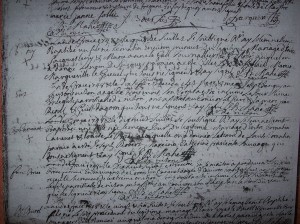The sources
1. Civil registration and ecclesiastical Records
It should be recalled that the clergy had been compelled to register baptisms only since 1539 by the edict of Villers-Cotterêts, under King Francis I.
Forty years later, King Henry III, through the edict of Blois in May 1579, will make it mandatory to register marriages and deaths. In practice, parish registers only date back to the beginning of the 17th century (when they haven’t been destroyed or lost).
In 1667, it becomes mandatory to keep duplicate copies of the records (it is often the starting point of currently existing archives, but in the North, this practice will become systematic only after 1737).
In 1747, death certificates are made distinct from other certificates (in order to ease the work for the officials from that time). The French Revolution brings us a calendar (said revolutionary), which will mislead people and allow errors to interfere with everybody’s genealogies for 16 years.
In 1887, the family record book makes its appearance (the spelling of the family name is fixed as it stood when the person was born, that is to say around 1830-1840).
Unfortunately, for the records, four centuries figure a lot: wear and tear, humidity, all sorts of parasites and human stupidity (indifference, wars…). Just imagine the Paris fire in 1871 that destroyed 8,500,000 certificates (from which only 2,500,000 could be reconstituted)!
2. Other sources
There are fortunately other archival sources than civil status, which sometimes go further back: notary archives (marriage contracts, inventories made after deaths, wills), cartularies and municipal, seigniorial or ecclesiastical archives…


